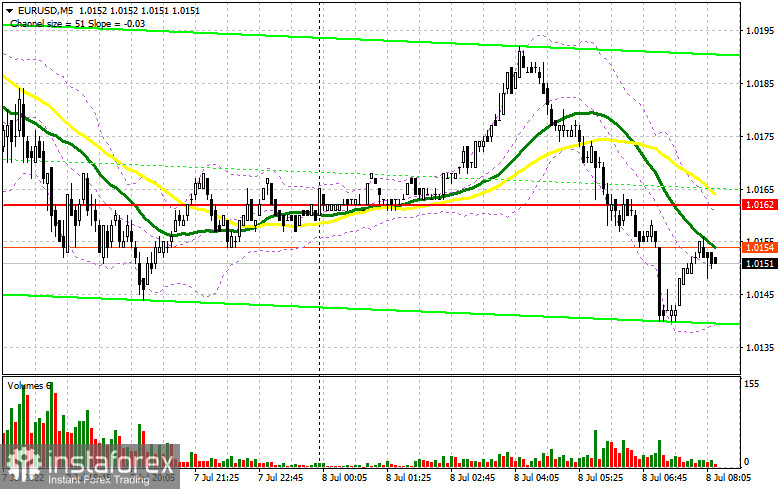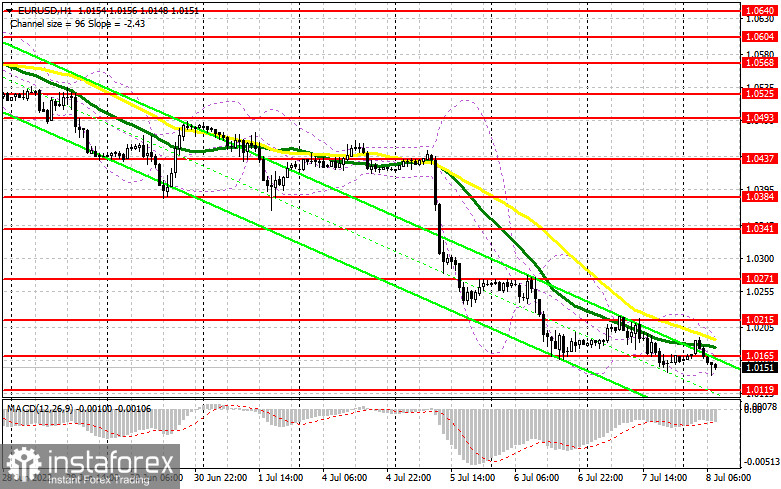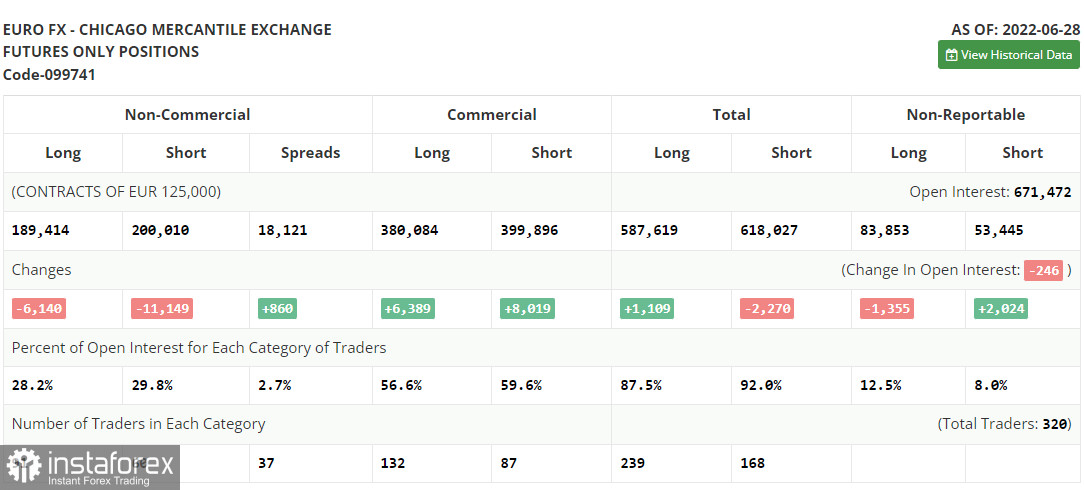Yesterday there were no signals to enter the market. Let's take a look at the 5-minute chart and see what happened. Speeches by representatives of the European Central Bank did not affect the euro's direction, as traders did not want to buy even at annual lows. Due to extremely low volatility, it was not possible to get comfortable entry points from 1.0200, as this level was "smeared" and apparently turned out to be wrong. Despite another decline in the euro and a revision of the technical picture in the afternoon, the bulls failed to protect the annual low. However, I did not see any sell signals there either.

When to go long on EUR/USD:
The euro continues to decline and renew annual lows, which indicates investors' fears for further growth rates of the European economy in the face of excessively high inflation and signs of an impending recession. Apparently, the European Central Bank's actions to stabilize the situation have not yet brought results. The expected interest rate hike also does not support the euro. Today, bulls could hope for the speech of European Central Bank President Christine Lagarde, which may affect future monetary policy.
As for the technical outlook, as long as trading is conducted below 1.0165, in my opinion, the pressure on EUR/USD will continue. For this reason, bulls need to regain control of this level as quickly as possible. In case the pair falls further, the optimal scenario for opening long positions will be when a false breakout is formed in the area of the nearest support at 1.0119, which creates a signal to enter the market, counting on an attempt to build at least some upward correction at the end of the week with the prospect of updating 1.0165, where the averages moving are, playing on the bears' side. Only a breakthrough and test of 1.0165 would hit bearish stops, opening 1.0215. However, we can only talk about a turning point of the bearish market after the release of data on the US labor market and a breakthrough of 1.0215, which will lead to an update of 1.0271 and 1.0341, where I recommend taking profits.
If the EUR/USD declines and there are no bulls at 1.0119, and this requires Lagarde's dovish rhetoric, I advise you not to rush to enter the market. The best option for opening long positions would be when a false breakout forms in the support area of 1.0072. I advise you to buy EUR/USD immediately on a rebound only from the low in the 1.0033 area, or even lower - in the 0.9995 area, counting on an upward correction of 30-35 points within the day.
When to go short on EUR/USD:
The bears are still coping with all the tasks and are in control of the market. The best option for selling the euro would be when a false breakout forms in the area of 1.0165, the protection of which will be another proof of the presence of big players in the market, betting on a further fall in risky assets. This creates a signal to open short positions with the prospect of updating the next annual low around 1.0119. A breakthrough and consolidation below this range, as well as a reverse test from the bottom up - all this will lead to another sell signal with the removal of bulls' stops and a larger movement of the pair down to the 1.0077 area and a good option for updating 1.0033, where I recommend completely exiting short positions. A more distant target will be the area of 0.0095. If EUR/USD moves up during the European session, as well as the absence of bears at 1.0165, the upward correction may increase significantly, however, it will hardly be possible to expect a more rapid upswing of the pair ahead of important statistics on the US labor market.
In case the pair rises above 1.0165, I advise you to postpone short positions to a more attractive level of 1.0215. Forming a false breakout there will be a new starting point for a downward correction of the pair. You can sell EUR/USD immediately on a rebound from the high of 1.0271, or even higher - in the area of 1.0341, counting on a downward correction of 30-35 points.

COT report:
The Commitment of Traders (COT) report for June 28 again logged a reduction in both long and short positions, but this did not lead to forming a larger negative delta, since there were much fewer short positions than long ones. European Central Bank President Christine Lagarde spoke last week, as did Federal Reserve Chairman Jerome Powell. They all spoke of the need to further raise interest rates in order to combat the highest inflation in recent memory. Let me remind you that this month the ECB intends to start raising interest rates, which should limit the dollar's upward potential against the euro. The data on inflation in the euro area, released last week, became another proof that it is no longer possible to delay. However, given the current situation in the global economy, there is now more demand for safe haven assets. We are waiting for parity in the EUR/USD pair. The COT report indicated that long non-commercial positions decreased by 6,140 to 189,414, while short non-commercial positions decreased by 11,149 to 200,010. In many developed countries - all this continues to push for long positions on the dollar. At the end of the week, the total non-commercial net position remained negative and amounted to -10,596 against -15,605. The weekly closing price dropped and amounted to 1.0584 against 1.0598.

Indicator signals:
Moving averages
Trading is below the 30 and 50-day moving averages, which indicates further decline in the pair.
Note: The period and prices of moving averages are considered by the author on the H1 hourly chart and differs from the general definition of the classic daily moving averages on the daily D1 chart.
Bollinger Bands
In case of a decline, the lower border of the indicator around 1.0125 will act as support. In case of growth, the upper border of the indicator in the area of 1.0175 will act as resistance.
Description of indicators
- Moving average (moving average, determines the current trend by smoothing out volatility and noise). Period 50. It is marked in yellow on the chart.
- Moving average (moving average, determines the current trend by smoothing out volatility and noise). Period 30. It is marked in green on the chart.
- MACD indicator (Moving Average Convergence/Divergence — convergence/divergence of moving averages) Quick EMA period 12. Slow EMA period to 26. SMA period 9
- Bollinger Bands (Bollinger Bands). Period 20
- Non-commercial speculative traders, such as individual traders, hedge funds, and large institutions that use the futures market for speculative purposes and meet certain requirements.
- Long non-commercial positions represent the total long open position of non-commercial traders.
- Short non-commercial positions represent the total short open position of non-commercial traders.
- Total non-commercial net position is the difference between short and long positions of non-commercial traders.
 English
English 
 Русский
Русский Bahasa Indonesia
Bahasa Indonesia Bahasa Malay
Bahasa Malay ไทย
ไทย Español
Español Deutsch
Deutsch Български
Български Français
Français Tiếng Việt
Tiếng Việt 中文
中文 বাংলা
বাংলা हिन्दी
हिन्दी Čeština
Čeština Українська
Українська Română
Română

